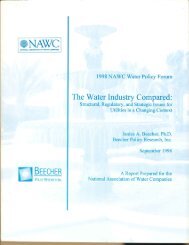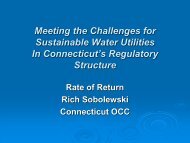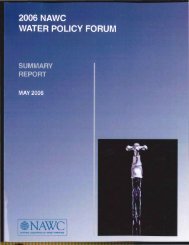CENTER FOR URBAN POLICY AND THE ENVIRONMENT - NAWC
CENTER FOR URBAN POLICY AND THE ENVIRONMENT - NAWC
CENTER FOR URBAN POLICY AND THE ENVIRONMENT - NAWC
You also want an ePaper? Increase the reach of your titles
YUMPU automatically turns print PDFs into web optimized ePapers that Google loves.
Indiana University + School of Public & Environmental AffairsCenter for Urban Policy & the EnvironmentThe social contract for the water industry should consider a number of additional structuralissues and related concerns. A fundamental concern is the uneven playing field between publicand private providers. Public providers have competitive advantages and generally are notregulated by the states. Another issue is the expansion and growth of water utilities into regionalwater service providers. Regionalization offers potential economies of scale and scope to theindustry. Many other considerations, such as watershed protection, also can be addressed moreeffectively at the regional level. If regionalization emerges as a policy goal, barriers to efficientrestructuring and consolidation should be addressed. Apparent agreement about the need toconsolidate water utilities is not always matched by favorable regulatory treatment of acquisitions.Diversification of the water industry into new markets and services, particularly in thewastewater business, also is an emerging issue. A key issue is how regulated utilities can competefor a place in these new markets, either directly or through subsidiaries. A related issue is theexpansion of other industries in the water sector. This may include other public utilities, such asthe electric industry, as well nonutility entities (such as private engineering and operations firms).The important role of water utilities in resource protection and conservation also should beaddressed. Society will continue to expect water utilities to act as conscientious "stewards" ofprecious water resources. This role will become more important as new sources of supply aremore costly to develop. Water utilities and utility regulators also must consider the issues ofaffordability and equity for low-income customers. With rising prices, ability to pay and thethreat of disconnection become major causes of concern.Coordination with other regulators is important for ensuring better utility performance. Inparticular, water quality, quantity, and economic standards set at the state level should be clearand consistent to encourage optimal utility performance. Additionally, positive performanceincentives should be provided through the regulatory process. Utilities that meet standards andrealize efficiencies also should realize the reward for efficient behavior, as in the competitivemarketplace. In some cases, ratepayers should share in these rewards. However, shifting all costsavings to customers leaves little incentive to utilities in terms of performance improvement andinnovation.In sum, a generalized regulatory framework is needed to strike a balance among the needsof the industry, the needs of water customers, and the needs of society as a whole. Optimal longtermsolutions may exact some short-term costs. Regulators must recognize and address thetradeoffs among various policy goals in crafting long-term solutions. Alternative regulatoryframeworks are emerging for the other utility industries, but not yet so for water. Because of itsessential and still rather monopolistic nature, the water industry merits special attention in thecontext of renegotiating the regulatory contract.18
















